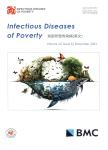Epidemiological features of seasonal influenza transmission among 11 climate zones in Chinese mainland
Epidemiological features of seasonal influenza transmission among 11 climate zones in Chinese mainland作者机构:Ecosystem Change and Population Health Research GroupSchool of Public Health and Social WorkQueensland University of TechnologyBrisbaneQLD 4059Australia Information CenterChinese Center for Disease Control and PreventionBeijing 102206China School of Mathematical SciencesQueensland University of TechnologyBrisbaneQLD 4000Australia
出 版 物:《Infectious Diseases of Poverty》 (贫困所致传染病(英文))
年 卷 期:2024年第13卷第1期
页 面:27-41页
核心收录:
学科分类:1004[医学-公共卫生与预防医学(可授医学、理学学位)] 1002[医学-临床医学] 1001[医学-基础医学(可授医学、理学学位)] 07[理学] 0707[理学-海洋科学]
基 金:National Foundation for Australia-China Relations, (220011) Department of Foreign Affairs and Trade, Australian Government, DFAT Queensland University of Technology, QUT
主 题:Seasonal influenza Koppen Geiger climate zones classification system Chinese mainland Seasonality decomposition Local indicators of spatial association
摘 要:Background Previous studies provided some evidence of meteorological factors influence seasonal influenza transmission patterns varying across regions and latitudes. However, research on seasonal influenza activities based on climate zones are still in lack. This study aims to utilize the ecological-based Koppen Geiger climate zones classification system to compare the spatial and temporal epidemiological characteristics of seasonal influenza in Chinese mainland and assess the feasibility of developing an early warning *** Weekly influenza cases number from 2014 to 2019 at the county and city level were sourced from China National Notifiable Infectious Disease Report Information System. Epidemic temporal indices, time series seasonality decomposition, spatial modelling theories including Moran’s/ and local indicators of spatial association were applied to identify the spatial and temporal patterns of influenza *** All climate zones had peaks in Winter-Spring season. Arid, desert, cold (BWk) showed up the first peak. Only Tropical, savannah (Aw) and Temperate, dry winter with hot summer (Cwa) zones had unique summer peak. Temperate, no dry season and hot summer (Cfa) zone had highest average incidence rate (IR) at 1.047/100,000. The Global Moran’s/ showed that average IR had significant clustered trend (z = 53.69,P 0.001), with local Moran’s/ identified high-high cluster in Cfa and Cwa. IR differed among three age groups between climate zones (0-14 years old:F = 26.80,P 0.001;15-64 years old:F = 25.04,P 0.001;Above 65 years old:F = 5.27,P 0.001). Age group 0-14 years had highest average IR in Cwa and Cfa (IR= 6.23 and 6.21) with unique dual peaks in winter and spring season showed by seasonality *** Seasonal influenza exhibited distinct spatial and temporal patterns in different climate zones. Seasonal influenza primarily emerged in BWk, subsequently in Cfa and Cwa. Cfa, Cwa and BSk pose high risk for seasonal



